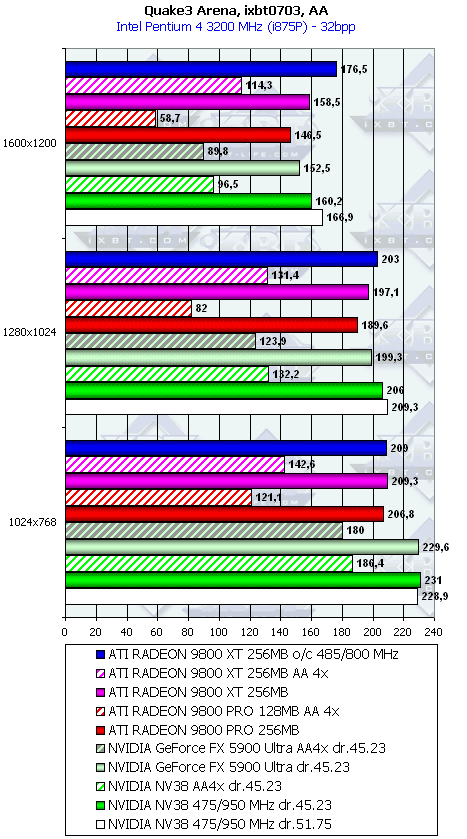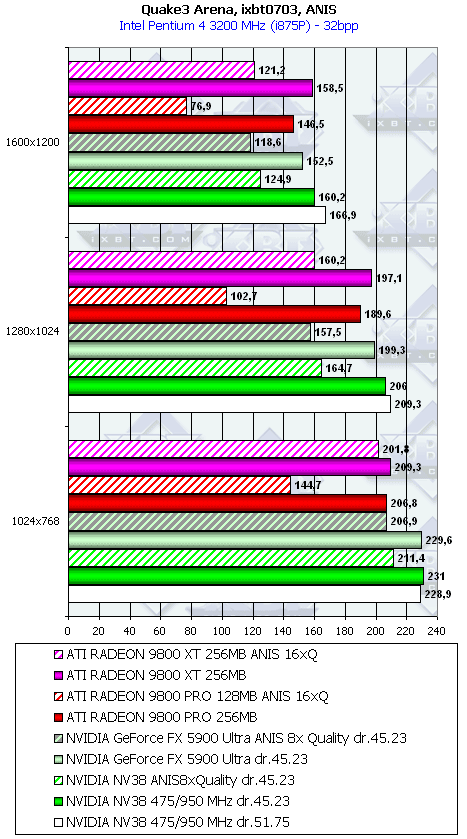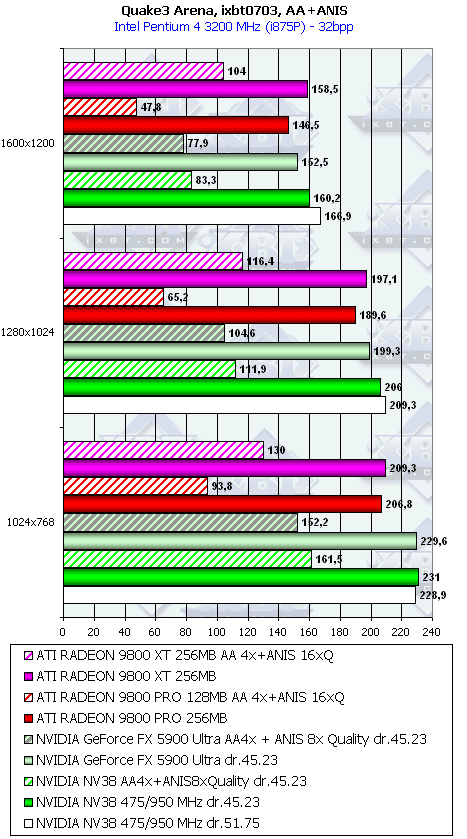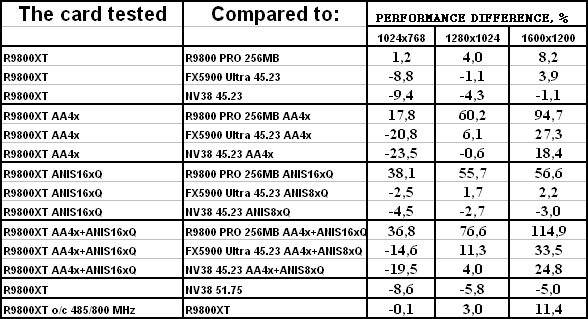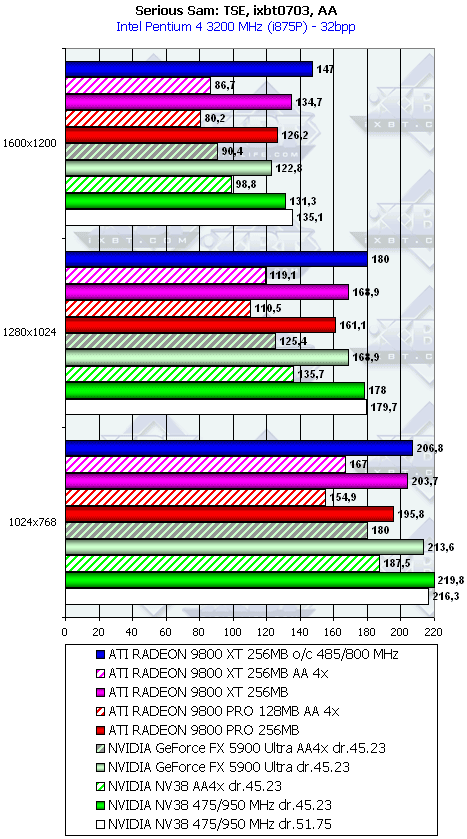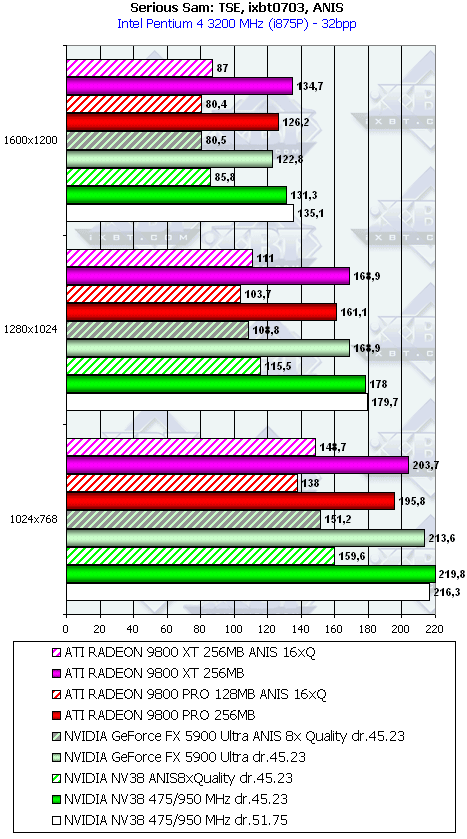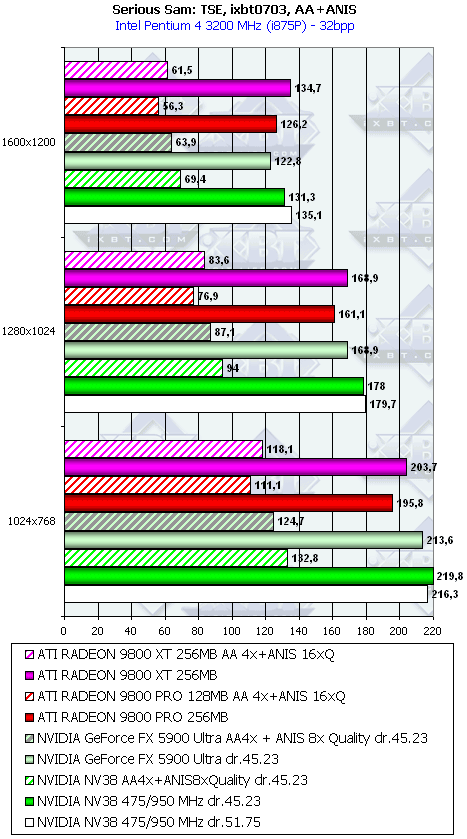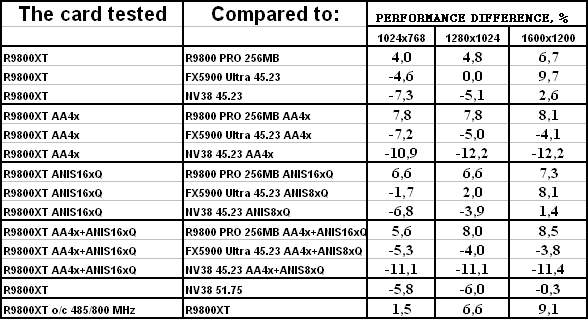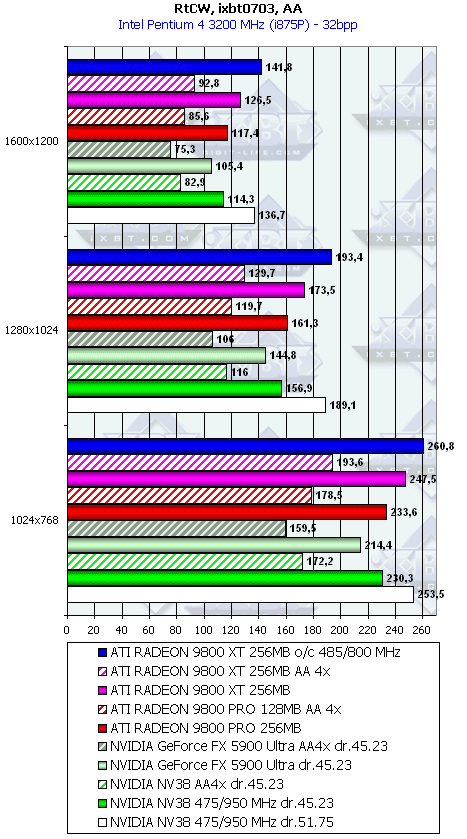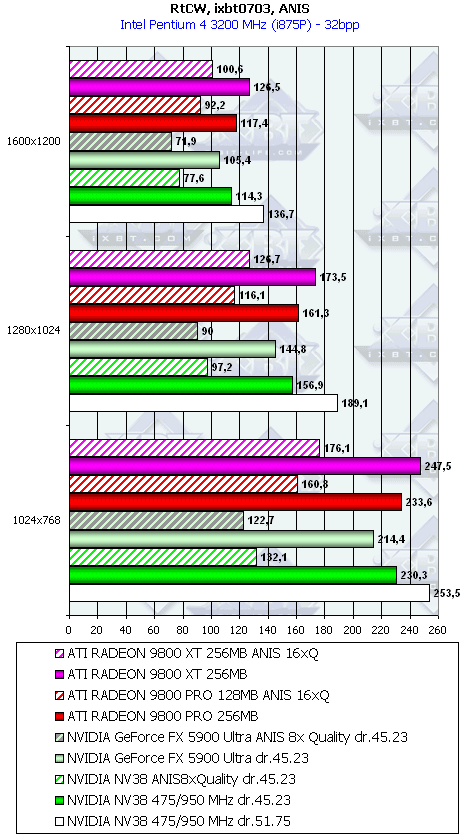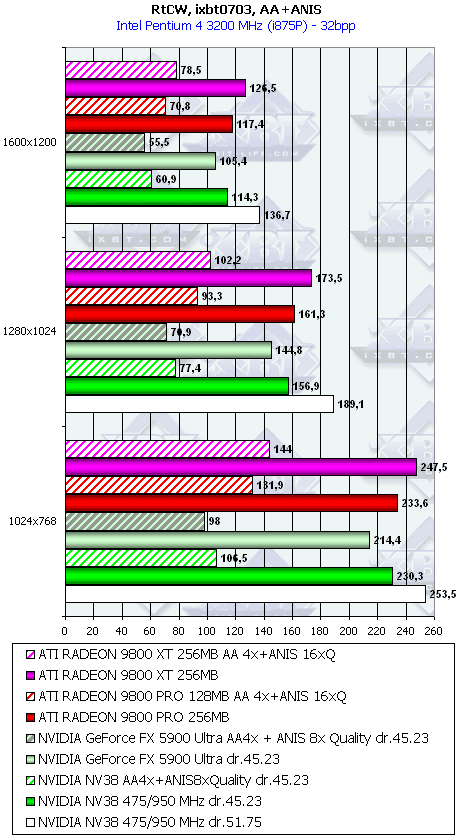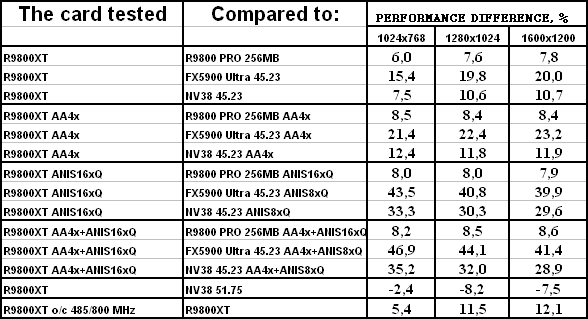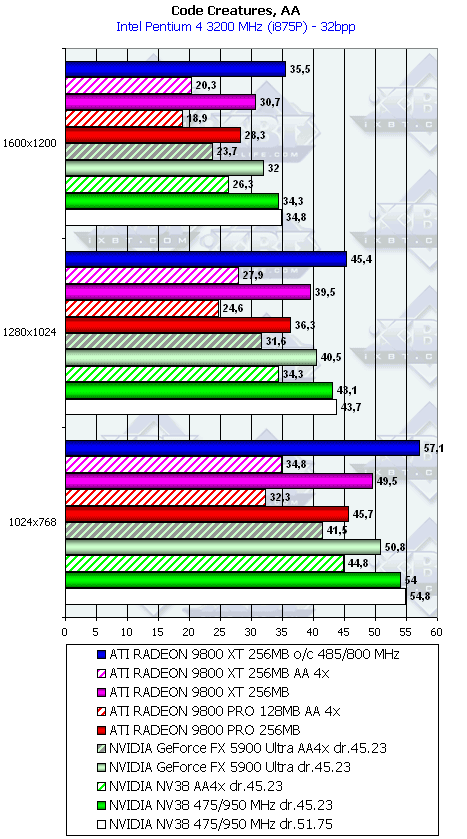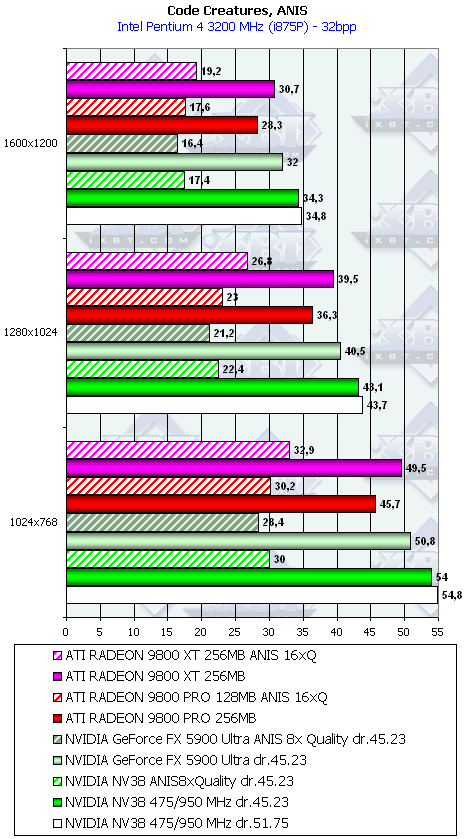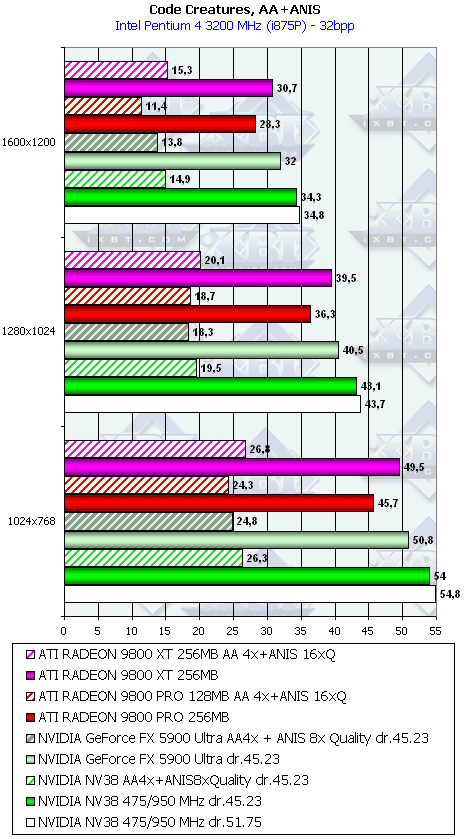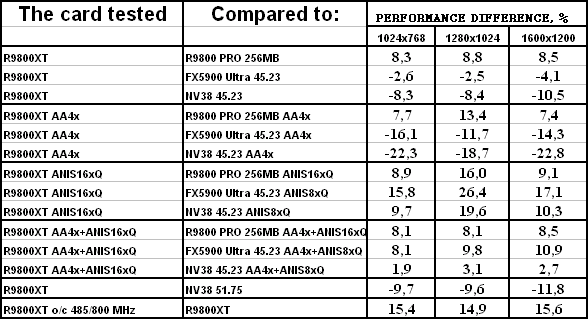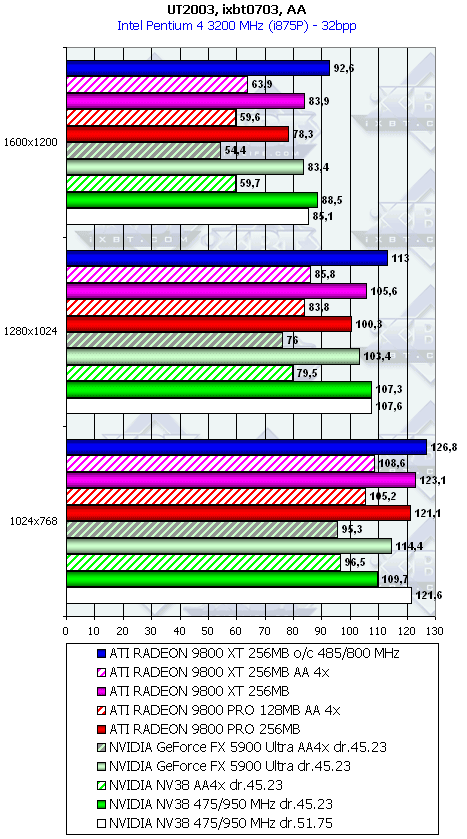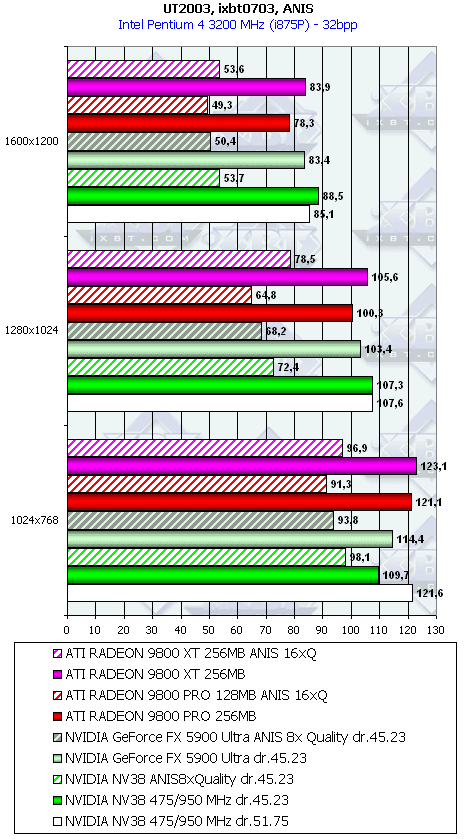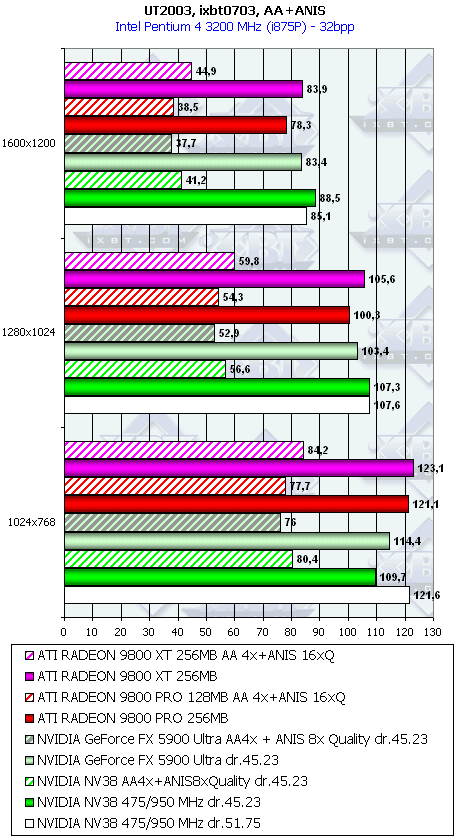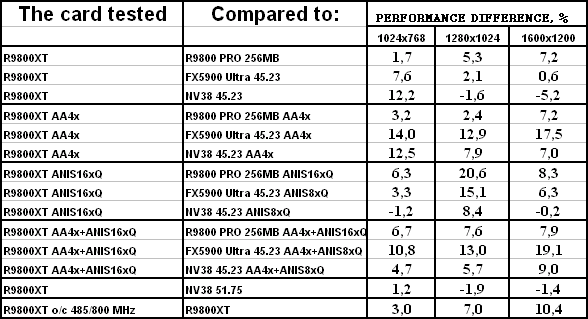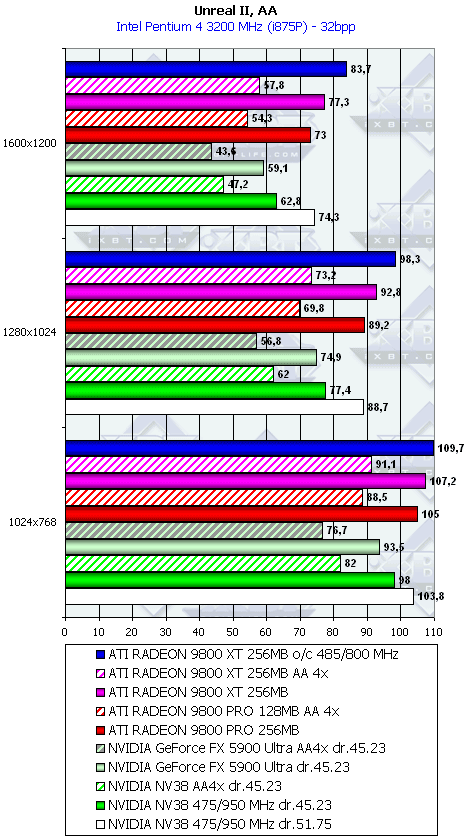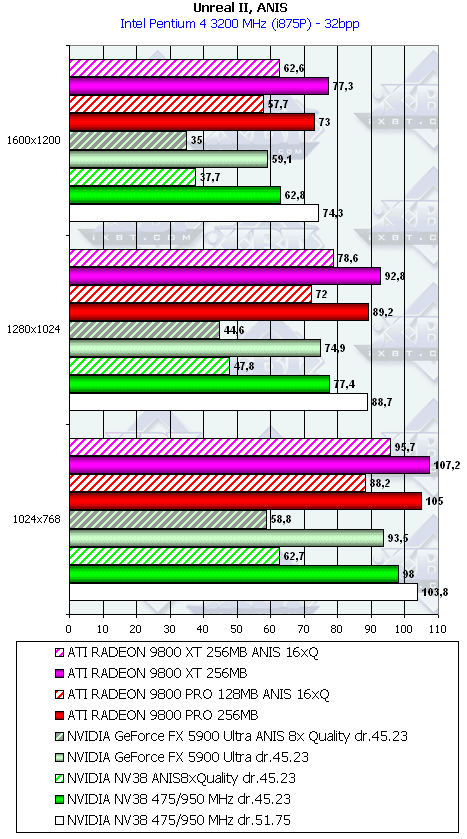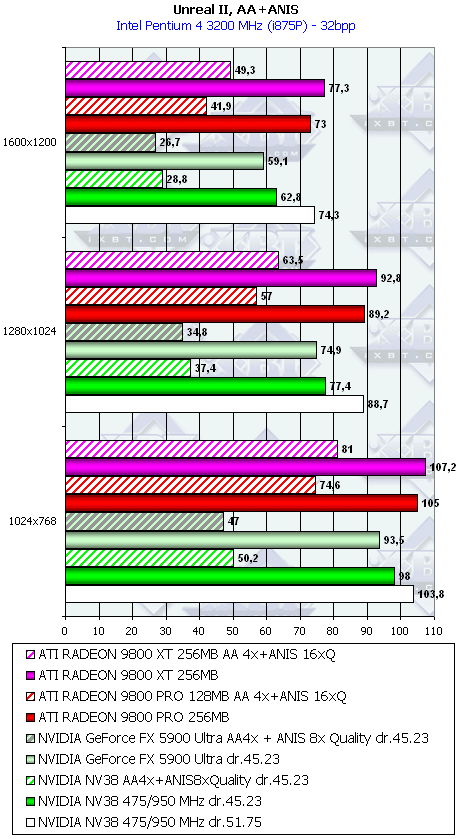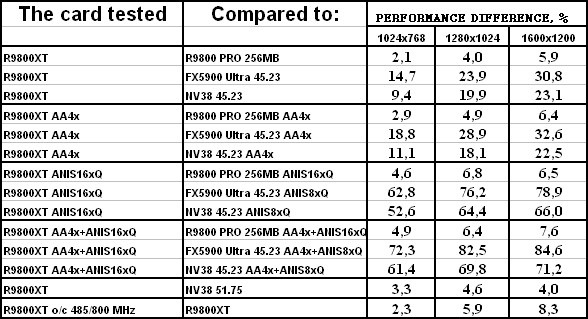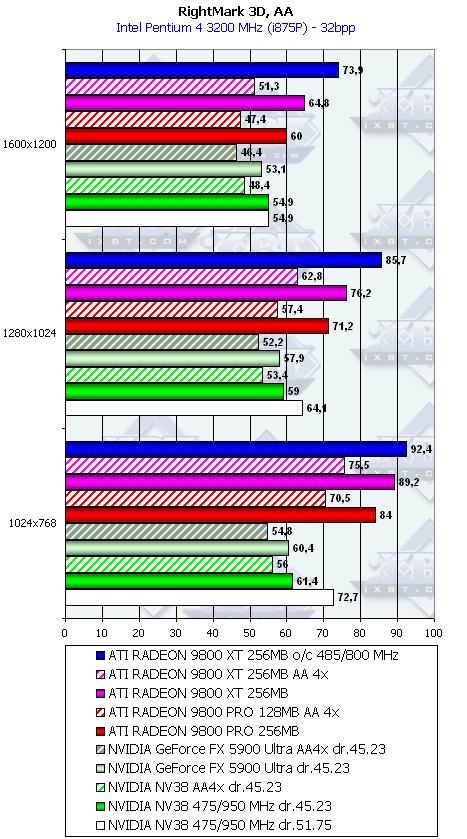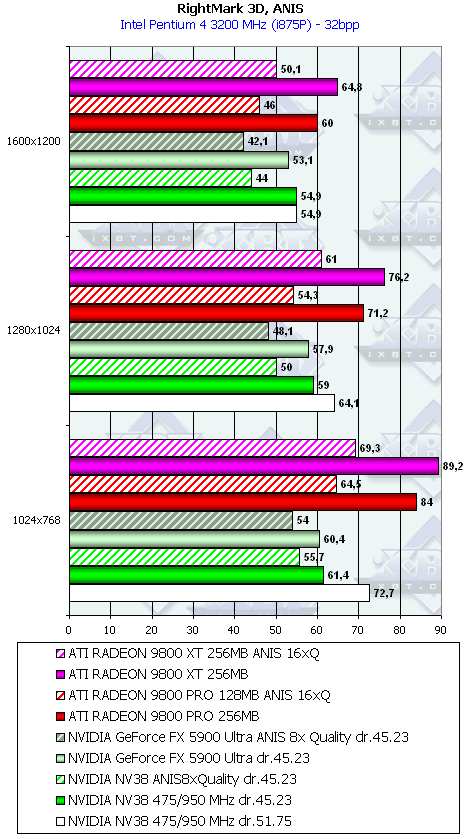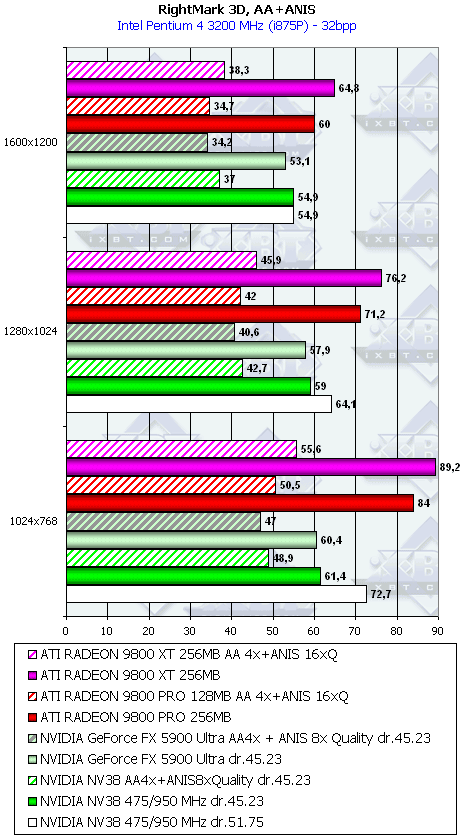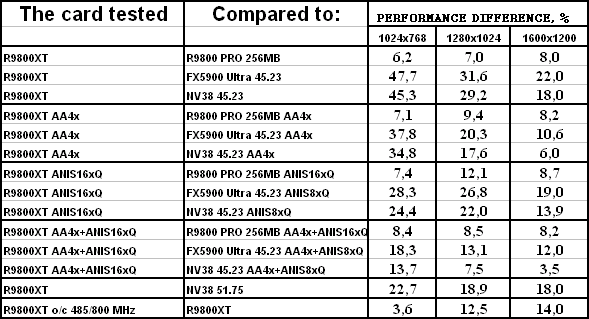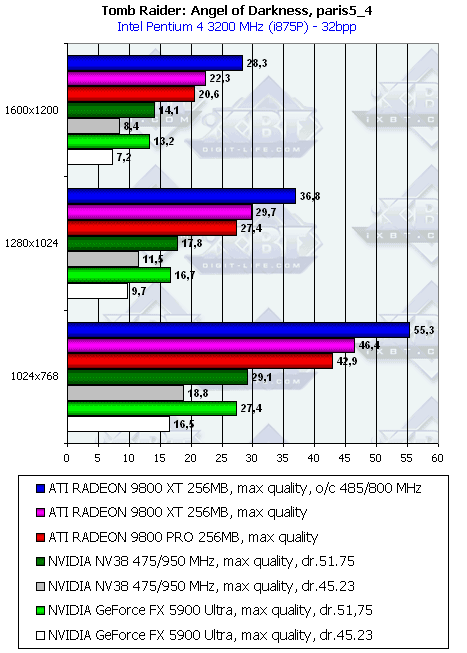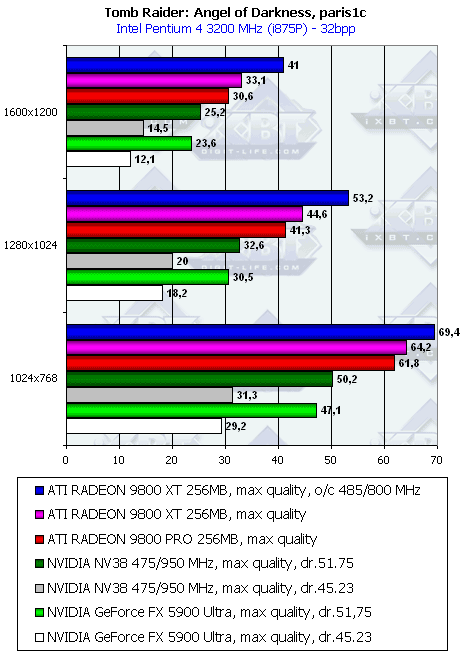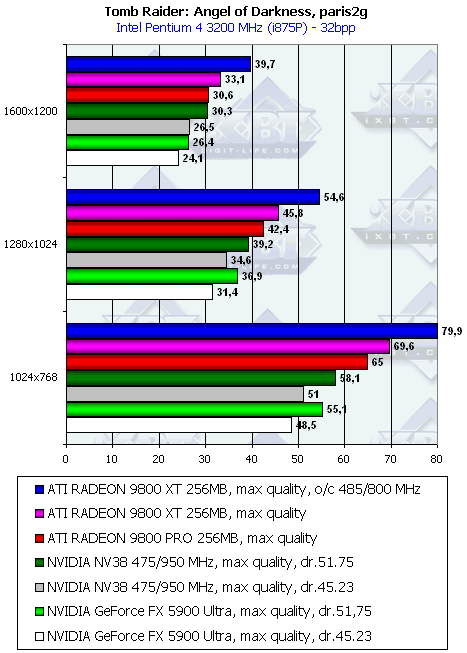ATI RADEON 9800 XT 256MB Card Review
|
Contents
- Video card features
- Testbed, test tools, 2D quality
- Quality issues: why this driver version
is used
- Test results: Quake3 ARENA
- Test results: Serious Sam: The Second Encounter
- Test results: Return to Castle Wolfenstein (speed and quality)
- Test results: Code Creatures DEMO
- Test results: Unreal Tournament 2003 (speed
and quality)
- Test results: Unreal II: The Awakening (speed
and quality)
- Test results: RightMark 3D
- Test results: TRAOD: Benchmarking in paris5_4
- Test results: TRAOD: Benchmarking in paris1c
- Test results: TRAOD: Benchmarking in paris2g
- Conclusion
On September 30 ATI pompously announced two new products: RADEON 9800XT
(former R3600) and RADEON 9600XT (former RV360). These two products
now crown their own niches: High-End and Middle-End respectively.
 Actually,
they are nothing but overclocked versions of the previous chips and cards. The
engineers worked well on improving the technological processes, and now we can
see new revisions of the R350 and RV350 able to run at higher clock speeds. But
the competition between NVIDIA and ATI is very tough, and the marketers decided
to give new names to the new revisions :-). Actually,
they are nothing but overclocked versions of the previous chips and cards. The
engineers worked well on improving the technological processes, and now we can
see new revisions of the R350 and RV350 able to run at higher clock speeds. But
the competition between NVIDIA and ATI is very tough, and the marketers decided
to give new names to the new revisions :-).
But in spite of the new names they are still based on ATI RADEON 9800
PRO and NVIDIA GeForce FX 5900 Ultra. By the way, the overclocked version
of the latter is codenamed NV38. As the RADEON 9800 is just a speedier
variant of the old processor in the reviews below to see what the R300
and its successor R350 are able of.
Theoretical materials and reviews of video cards which concern functional
properties of the GPU ATI RADEON 9500/9600/9700/9800
- Analysis of RADEON 9700 architecture
and Microsoft DirectX 9.0
- ATI RADEON 9700 Pro 128MB Review
- Gigabyte MAYA II R9700Pro 128MB
- performance estimated on the new Pentium 4 2.53 GHz based platform, comparison
with the NVIDIA's 40.41 driver
- Hercules 3D Prophet 9700
Pro 128MB - new CATALYST 2.3 driver estimated in 3DMark2001 SE, and Unreal
Tournament 2003 DEMO final release
- PowerColor Evil Commando2 RADEON 9700 Pro 128MB - performance
of the new CATALYST 2.3 driver estimated in game tests, 3D quality issues
- Hercules 3D Prophet 9700 Pro
on ATI RADEON 9700 Pro: extreme overclocking
- ATI RADEON 9500, 9700 and Gigabyte
MAYA II RADEON 9500
- Sapphire Atlantis RADEON
9500 128MB and videocards tests in DOOM III v.0.02
- ATI RADEON 9500 PRO 128MB
- Gigabyte MAYA II RADEON
9500 PRO and Hercules 3D Prophet 9500 PRO - detailed analysis of anisotropic
filtering of RADEON 9700
- Sapphire Technology RADEON
7500, 8500, 9000/Pro, 9700 Pro, anisotropic filtering of RADEON 9700
- HIS Excalibur RADEON 9700 PRO
- Tests in DirectX 9.0 RC0
- ATI RADEON 9500 64MB,
9500 128MB, 9500 PRO, 9700 and 9700 PRO in DirectX 9.0: Part 1 - Game tests in
3DMark2001, and Soft9700!
- ATI RADEON 9500 64MB,
9500 128MB, 9500 PRO, 9700 and 9700 PRO in DirectX 9.0: Part 2 - Tests in DirectX
9.0 - synthetic tests from RightMark 3D
- Sapphire Atlantis
RADEON 9700 and RADEON 9700 PRO Ultimate Edition
- YUAN SmartVGA RADEON 9000 64MB
and RADEON 9700 PRO
- Connect3D video cards
on the ATI's chips
- ATI RADEON 9800 PRO 128MB
- ATI RADEON 9600 PRO 128MB: Part 1 - game tests and
performance
- Hercules 3D Prophet 9800 PRO 128MB and Hercules
3D Prophet 7500 128MB, and scandal around the 3DMark03
- Hercules 3D Prophet 9800 PRO 128MB and Hercules
3D Prophet 7500 128MB (single page)
- Sapphire Technologies ATI RADEON 9200/9600/9600PRO/9800PRO
video cards
- Connect3D, Gigabyte and CP.Technology ATI RADEON
9800 PRO video cards
- Sapphire Atlantis RADEON 9600 256MB, Sapphire Atlantis
RADEON 9600 PRO Ultimate Edition 128MB, Gigabyte RADEON 9600 PRO 128MB, Hercules
3D Prophet 9600 PRO 128MB
- Manli RADEON 9800 PRO 256MB on ATI RADEON 9800
PRO
- ATI RADEON 9600/9600 PRO based cards from Gigabyte,
Hercules and Sapphire
- Sapphire Atlantis RADEON 9800 PRO 256MB Ultimate
Edition on ATI RADEON 9800 PRO - graphics quality in UT2003/Unreal II and
other games, tricks with anisotropy
- Connect3D ATI RADEON 9200/9600/9600 PRO/9800 PRO
- TYAN Tachyon G9600 PRO 128MB on ATI RADEON 9600 PRO
- Sapphire Atlantis RADEON 9200 PCI 64MB 64bit, Sapphire
Atlantis RADEON 9200SE 128MB, Sapphire Atlantis RADEON 9800SE 128MB 128bit, Sapphire
Atlantis RADEON 9800 128MB, Sapphire Atlantis RADEON 9800 PRO Lite 128MB, PowerColor
RADEON 9800SE 128MB 256bit
So, what's the difference between the R360 and its predecessor?
Actually, only the clock speeds differ. The RADEON 9800 PRO has its core
clocked at 380 MHz while the memory speed depends: the 128MB card has DDR
memory working at 340 (680) MHz and the 256MB one has the 350 (700) MHz DDR-II
memory.
 The RADEON 9800 XT has the clock speeds of 412/365 (730) MHz and is equipped with
the 256MB DDR. The memory modules are bigger, and they are 8 instead of 16.
The RADEON 9800 XT has the clock speeds of 412/365 (730) MHz and is equipped with
the 256MB DDR. The memory modules are bigger, and they are 8 instead of 16.
Does such announcement make sense? As you know, the latest High-End
accelerators were pretty expensive, and the prices fall down too slowly.
The recommended price for the newcomer is $499. I suppose that 256MB RADEON
9800 PRO will either leave the market (the production volumes of such cards
weren't great), or step down the price ladder. The first is more likely.
The RADEON 9800 XT will simply replace the odd 256MB version of the R350,
which had expensive DDR-II memory of the unneeded 256MB size. Besides, it
was $100 dearer. At the same time, the breakaway from the 128MB card was
inconsiderable.
That is why the R360 was aimed at replacing unpopular and unsuccessful
RADEON 9800 PRO 256MB, and strengthening ATI's leading position in 3D performance.
What about NVIDIA? Their response is the upcoming NV38. This is
also actually an overclocked version of the NV35. And we will try to compare
ATI's card with the GeForce FX 5900 Ultra overclocked up to the speeds of
the NV38. But it's just a trial test because NVIDIA hasn't released it officially.
The clock speeds of the NV38 are taken from the Anandtech's
site.
Card
| ATI RADEON 9800 XT 256MB |

|
| ATI RADEON 9800 XT 256MB |
| AGP x8/x4 interface, 256 MB DDR SDRAM memory in 8 chips
on both PCB sides. It's the first time the 256Mbit chips are packed in BGA.
Earlier 256 MB was built up from 8 chips in TSOP package or 16 BGA chips.
Hynix 2.5ns memory chips (marked HY5DU573222)
correspond to 400 (800) MHz but the memory works at 365 (730) MHz. GPU clocked
at 412 MHz. 256bit memory interface.
|

|
| Comparison with the RADEON 9800 PRO, front view |
| ATI RADEON 9800 XT 256MB |
Reference card ATI RADEON 9800 PRO |

|

|

|
| Comparison with the RADEON 9800 PRO, back view |
| ATI RADEON 9800 XT 256MB |
Reference card ATI RADEON 9800 PRO |

|

|

|
|
The design is slightly altered, though it's basically the same. The space
left for the Rage Theater chip indicates that the card can support VIVO. The higher
the memory speed the better cooling is needed. It's the first time when ATI uses
heatsinks for the memory chips.
| ATI RADEON 9800 XT 256MB |
|
The cooler differs much from earlier used solutions. Previous cards had a
small heatsink with a fan in the center, and this one is equipped with a massive
copper heatsink with the fan shifted off from the core center.
A similar cooler design was first used one and a half years ago on a GeForce4
Ti based card. The principle of operation is that air gets into the closed sink
and blows over the hot processor.
I'm glad ATI changes its attitude towards appearance of their products and
now we can see a really beautiful cooler,which is also very effective. Besides,
it's not big and the card takes only one AGP slot.
On the back you can see a copper plate that is pressed against the memory chips
with two strainers (both sinks are fastened with the screws on top). A jut on
the plate is pressed against the PCB part where the core is located.
|

|

|

|
Here's the graphics processor (like the R350, it has a mirror surface):
As I already mentioned, the cooler is pretty compact and low, that is why it
doesn't lock the first PCI slot. The fan sits high but it's shifted well to the
left, that is why installation of low-profile PCI cards won't hamper cooling.
Note that the card can support VIVO if ATI's partners install the Rage Theater
chip on it.
Testbed and drivers
Testbed:
- Pentium 4 3200 MHz based computer:
- Intel Pentium 4 3200 MHz CPU;
- DFI LANParty Pro875 (i875P) mainboard;
- 1024 MB DDR SDRAM;
- Seagate Barracuda IV 40GB HDD;
- Windows XP SP1; DirectX 9.0a;
- ViewSonic P810 (21") and ViewSonic P817 (21")
monitors.
- ATI drivers v6.378.
VSync off, S3TC off in applications.
Cards used for comparison:
- ATI RADEON 9800 PRO (380/350 (700) MHz, 256 MB DDR).
- ASUS V9950 Ultra (GeForce Fx 5900 Ultra, 450/425 (850) MHz, 256 MB DDR, driver
45.23, 51.75).
Test results
Before we start examining 2D quality, I should say there are no complete techniques
for objective 2D quality estimation because:
- 2D quality much depends on certain samples for almost all modern 3D accelerators;
- Besides videocards, 2D quality depends on monitors and cables;
- Moreover, certain monitors might not work properly with certain video cards.
With the ViewSonic P817 monitor and BNC Bargo cable the card showed excellent
quality at the following resolutions and clock speeds:
|
| ATI RADEON 9800 XT 256MB |
1600x1200x85Hz, 1280x1024x120Hz, 1024x768x160Hz |
Quality issues: why these driver versions are used
First of all, we do not carry out synthetic tests because it's obvious that
overclocking won't change the situation much - the correlation of the test results
will remain the same. You can look at the current situation from Alexander Medvedev's
recent article.
Secondly, in comparison of the RADEON 9800 XT with its competitors
we will use NVIDIA's drivers of the version 45.23 (official release, WHQL).
The results obtained with the v51.75 will be also provided, but this version
is still raw and has many flaws. Have a look at some examples from the RtCW
and Unreal II.
|
| RADEON 9800 |
FX 5900 driver 45.23 |
FX 5900 driver 51.75 |
| Unreal II, Example 1 |

|

|

|
| Unreal II, Example 2 |

|

|

|
| Unreal II, Example 3 |

|

|

|
| RADEON 9800/FX 5900 driver 45.23 |
FX 5900 driver 51.75 |
| RtCW |

|

|
|
The Unreal II game has problems with fog on the v51.75 while in the RtCW some
objects are light-struck (the problems with multitexturing and lightmaps?). As
you can see, the driver 51.75 speeds up the GeForce FX family exactly in these
games. There are some other problems with quality on these drivers. Look for more
information in our September's 3Digest.
That's why I can't use drivers of such quality in comparison with
the performance on ATI's WHQL drivers. And in NVIDIA's case we used only
v45.23 to compare the cards' performance.
The newer drivers will be used only in the TR:AoD benchmark where
the Depth of Field functions incorrectly on v45.23 and doesn't show any bugs
on v51.75. In general, this benchmark works more or less well on these drivers.
Test results: performance
Conventional signs: ANISO 8xP - Anisotropic 8x Performance (earlier
it was called Balanced), ANISO 8xQ - Anisotropic 8x Quality, ANISO 16xQ -
Anisotropic 16x Quality.
Some time ago we decided not to compare ATI's maximum anisotropic
quality of 16x to two NVIDIA's modes anymore. The ANISO 8x Quality mode
provided the real maximum quality with both trilinear filtering and
anisotropy working to their full capacity. The ATI 16x Quality showed
sharper images due to the 16th degree but on some surfaces the filtering
quality reduced. That's the way ATI's anisotropy works. That is why
we thought it was more correct to compare exactly this ATI's mode with
NVIDIA's Performance and Quality ones.
But NVIDIA's today's optimization policy changes the things and
we do not know anymore if there are applications where NVIDIA's anisotropy
works to its full capacity. That is why we consider it to be correct to compare
ANISO 16xQ (ATI) to ANISO 8xQ (NV). Both have their strong and weak points,
but in general they compensate each other.
Test applications:
Return to Castle Wolfenstein (MultiPlayer) (id Software/Activision) - OpenGL,
multitexturing, ixbt0703-demo, test settings - maximum, S3TC OFF, the configurations
can be downloaded from here
Serious Sam: The Second Encounter v.1.05 (Croteam/GodGames) - OpenGL, multitexturing,
ixbt0703 demo, test settings: quality, S3TC OFF
Quake3 Arena v.1.17 (id Software/Activision) - OpenGL, multitexturing, ixbt0703
demo, test settings - maximum: detailing level - High, texture detailing
level - #4, S3TC OFF, smoothness of curves is much increased through variables
r_subdivisions "1" and r_lodCurveError "30000" (at default r_lodCurveError
is 250 !), the configurations can be downloaded from here
Unreal Tournament 2003 v.2225 (Digital Extreme/Epic Games) - Direct3D, Vertex
Shaders, Hardware T&L, Dot3, cube texturing, default quality
Code Creatures Benchmark Pro (CodeCult) - the game that demonstrates card's
operation in DirectX 8.1, Shaders, HW T&L.
Unreal II: The Awakening (Legend Ent./Epic Games) - Direct3D, Vertex Shaders,
Hardware T&L, Dot3, cube texturing, default quality
RightMark 3D v.0.4 (one of the test scenes) - DirectX 8.1, Dot3, cube texturing,
shadow buffers, vertex and pixel shaders (1.1, 1.4).
Tomb Raider: Angel of Darkness v.49 (Core Design/Eldos Software)
- DirectX 9.0, three demo scenes, maximum quality, Depth of
Fields PS20 off. The settings are equal for all the cards tested.
|
For the RADEON 9800 PRO and GeForce FX 5900 cards the game and the
patch 49 were reinstalled after the cards from one camp were tested so that
the game settings don't get mixed. If you need patch 49 which is not easy
to find and the demo benchmarks let me know by email.
Quake3 Arena
The light modes without AA and anisotropy: there's no a definite
leader - the 9800 XT and NV35 alternately take the crown. Emulation of the
NV38 improved its performance a little.
AA enabled: the 9800 XT reigns except in 1024x768.
Anisotropy enabled: approximate parity.
AA & anisotropy enabled: RADEON 9800 XT wins.
Serious Sam: The Second Encounter
The light modes without AA and anisotropy: the cards look more
or less equal.
AA enabled: the card loses the battle.
Anisotropy enabled: approximate parity.
AA & anisotropy enabled: RADEON 9800 XT falls a little behind
its competitors.
Return to Castle Wolfenstein (Multiplayer)
The light modes without AA and anisotropy: the 9800 XT wins.
AA enabled: the same.
Anisotropy enabled: the victory is even brighter.
AA & anisotropy enabled: RADEON 9800 XT scores excellent results
and shows a solid breakaway!
Code Creatures
The light modes without AA and anisotropy: the 9800 XT loses.
AA enabled: the 9800 XT loses even more (NVIDIA's optimizations
work!).
Anisotropy enabled: the 9800 XT grasps the victory (NVIDIA's method
filters almost every blade).
AA & anisotropy enabled: the RADEON 9800 XT is slightly ahead due
to its anisotropy.
Unreal Tournament 2003
The light modes without AA and anisotropy: if it beats the 5900
Ultra it steps back in front of the NV38.
AA enabled: the 9800 XT wins.
Anisotropy enabled: the 9800 XT wins again, though the competition
against the NV38 looks more complicated.
AA & anisotropy enabled: the RADEON 9800 XT wins!
Unreal II: The Awakening
In the light modes without AA and anisotropy and with these functions
enabled the RADEON 9800 XT comes out victor!
RightMark 3D
The test is entirely based on shaders, which is a problem for the
NV35/38. That is why the R9800 XT easily wins.
TR:AoD, Paris5_4 DEMO
This is the toughest test regarding shader speed.
No doubt ATI's card triumphs.
TR:AoD, Paris1c DEMO
This scene uses fewer shaders that is why the GeForce FX comes
closer to the RADEONs, though the gap is still wide.
TR:AoD, Paris2g DEMO
This test has few shaders, and the cards perform very close to
each other, though the RADEON is still ahead.
Conclusion

If we sum it up, the RADEON 9800 XT looks a new 3D king. There are some tests
where it yields to its counterpart but remember that we used the overclocked NV35
as the NV38, i.e. NVIDIA's driver didn't know that we wanted the speed of the
NV38: the DeviceiD usually has an effect on the driver optimizations. I hope the
emulated NV38 won't differ much from the real one, and we won't have to retest
the cards.

It's also obvious that the RADEON 9800 XT does not press down the former top
card but replaces the unsuccessful 256MB RADEON 9800 PRO. That is why they have
equal prices. But we don't know how NVIDIA is going to position its NV38. Probably,
their product will also replace the 5900 Ultra.
If you already have a card of the level of RADEON 9800 and GeForce
FX 5900, it's not worth replacing them as the new-comers are not attractive
that much. The speed gain is not great.

Those who are ready to pay $500 and haven't made their choice should definitely
consider the RADEON 9800 XT. It doesn't make sense to go with the RADEON 9800
PRO, and the GFFX 5900 Ultra is slower in shaders (a card for $500 is not going
to be used for old games, right?). Although this is a marketing product, it will
get a certain marketshare as thanks to its leadership. Stay tuned!
In our 3Digest you can find full comparison
characteristics for video cards of this and other classes.
|
|



